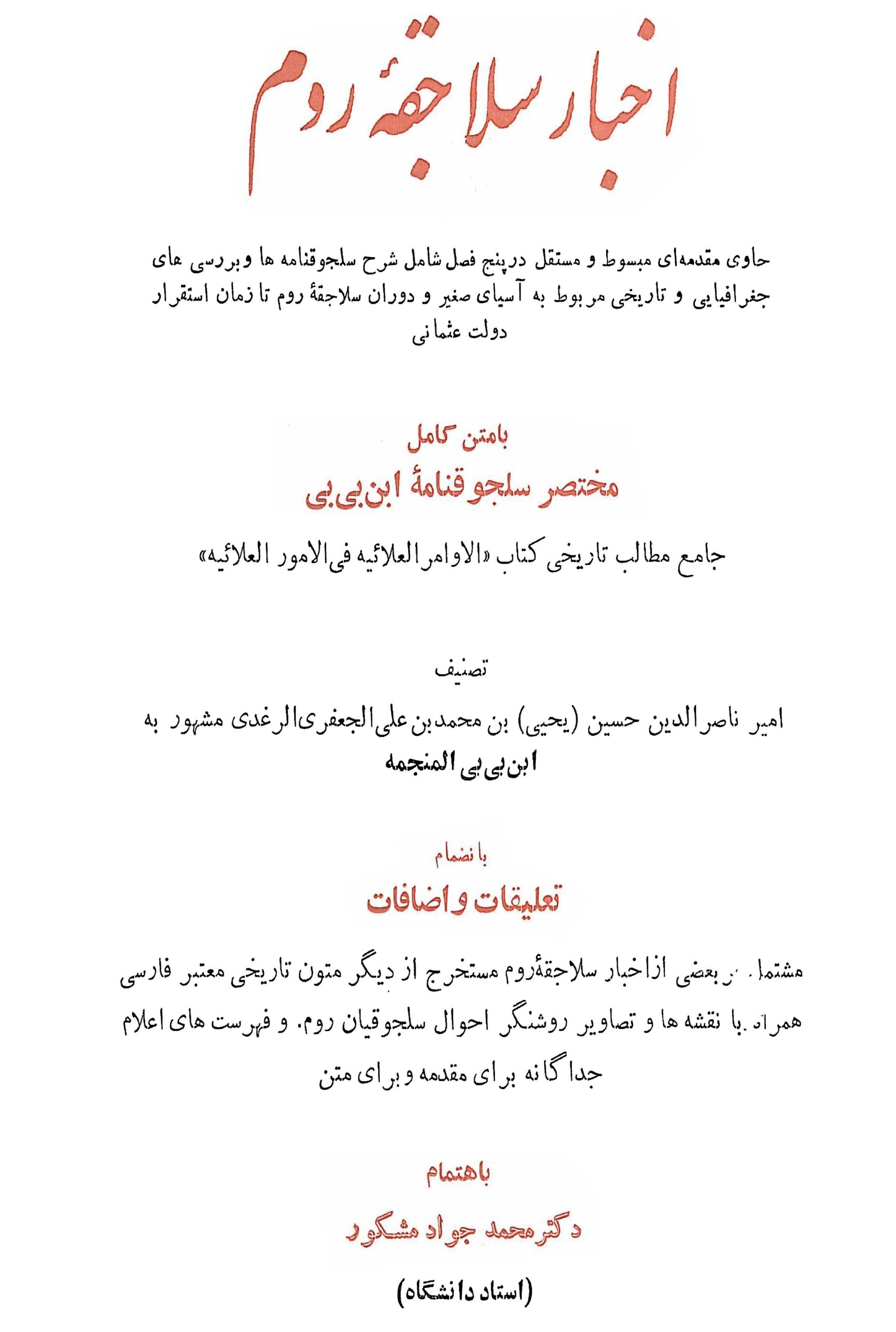Classical Persian through Historical Texts: From Naršaxī to Juwaynī
October 21st - November 7th
Online Course (3 weeks)
Course Outline
Instructor: Ruben S. Nikoghosyan
Languages: English, Persian
Duration of the Course: 3 weeks (12 days/24 hours)
Frequency: 4 classes per week (Monday-Thursday)
Duration of each Class: 2 hours (6 pm Yerevan Time)
Participation Fee:
- 2 weeks – 260 USD
- 3 weeks – 320 USD
Deadline for Applications: October 11th (extended to the October 17th)
Level of Persian: Intermediate, Advanced
Location: Online (Zoom classroom)
Texts:
- Abū Naṣr Aḥmad al-Qubāwī, Tarjuma-yi Tārīx-i Buxārā of Naršaxī
- Unknown,Tārīx-i Sīstān
- Abu-l-Šaraf Jurfādeqānī, Tarjuma-yī Tārīx-i Yamīnī of ‘Utbī
- Ibn Bībī, Axbār-i Salājiqa-yi Rūm
- ‘Alā-ud-Dīn Aṭāmalik Juwaynī, Tārīx-i Jahān-gušāy
Registration: Please click on the Apply button above and after filling in all the boxes (all boxes are necessary) click Submit. We will contact you if your application is accepted, and send you further instructions for participation.
Note: All materials are provided by the instructor.


Course Description
The Online Course “Classical Persian through Historical Texts: From Naršaxī to Juwaynī” is a one-of-its-kind intensive online course designed to provide its participants with all the tools to start working with complex historical texts in Classical Persian in a very short period of time.
Besides such practical activities, as reading and analysing texts in critical editions, as well as manuscripts, which form the focal part of the course, it is also intended to provide the participants with a broader understanding of the history of Persian language, Persianate textual and writing traditions, and their impact on Modern Persian.
Simultaneously, we will also be paying attention to the grammatical, phonetical, and etymological peculiarities of Classical Persian in comparison to both to Middle and Modern Persian, intended to enhance the participants’ understanding of historical, linguistic and philological issues of the Persian Classical historiography
Why Participate in This Course?
- Master the Language of the Classical Persian Historical Texts: Gain the ability to read, analyze, and interpret complex Classical Persian texts from various historical periods and regions.
- Comprehensive Exposure: Work with critical editions and manuscripts, developing skills to navigate texts from diverse geocultural regions like Central Asia, Afghanistan, and Anatolia.
- Deepen Linguistic Understanding: Learn about the grammatical, phonetic, and etymological nuances of Classical Persian, with comparisons to Middle and Modern Persian.
- Broaden Historical Insight: Explore the historical context of Persianate societies and the development of Persian historiograpy through dynasties like the Samanids, Ghaznavids, Seljuks, and Chingizids.
- Build Independence in Research: Walk away with the tools to confidently tackle historical texts on your own, thanks to our detailed philological, historical-linguistic, and literary approach.
- Expert Instruction: Benefit from the instructor’s specialized knowledge in both pre-Islamic Persian language and broader Persianate literary traditions, ensuring rich and nuanced explanations.
Read the Testimonials of Our Students
The Scope of the Course
The main goal of the course is to cover a group of five texts, each of which is a representative of a particular style, period, and region. These are the main texts which we will be reading during the course:
- Abū Naṣr Aḥmad al-Qubāwī, Tarjuma-yi Tārīx-i Buxārā of Naršaxī (2 days)
- Unknown,Tārīx-i Sīstān (2 days)
- Abu-l-Šaraf Jurfādeqānī, Tarjuma-yī Tārīx-i Yamīnī of ‘Utbī (3 days)
- Ibn Bībī, Axbār-i Salājiqa-yi Rūm (2 days)
- ‘Alā-ud-Dīn Aṭāmalik Juwaynī, Tārīx-i Jahān-gušāy (3 days)
Each one of these texts belongs or focuses on a specific geocultural region within the Greater Iranian area, such as Central Asia (Bukhara, Marv), Afghanistan (Sīstān, Ghaznī), Anatolia. The reigning dynasties cover the Samanids, Saffarids, Ghaznavids, Seljuks and Chingizids.
Through such a diverse array of periods, regions and styles, the participants of the course will fully immerse themselves in the subtleties of Classical Persian historical prose and come out with all the necessary confidence for tackling all sorts of historical texts written in Classical Persian.
Methodology
In my courses, I employ a simple yet highly effective method that combines literary, historical-linguistic, and philological approaches to clarify even the most obscure passages and words of a given text.
During this course, I will draw on my expertise in pre-Islamic (Middle) Persian language and literature, as well as my knowledge of both Iranian and non-Iranian languages, broader historical and geographical contexts, and, most importantly, literary contexts. This will help illuminate the meanings of the words, expressions, and ideas found in the text.
This method, which fundamentally involves explaining the underlying basis and logic of the text, will enable participants not only to understand the historical works covered during the course but also to equip them with the necessary tools to read other historical Classical Persian texts independently.
Readings
Day 1-2. Abū Naṣr Aḥmad al-Qubāwī, Tarjuma-yi Tārīx-i Buxārā of Naršaxī (2 days).
Edition: Abu Bakr Muḥammad b. Ja’far al-Naršaxī, Tārīx-i Buxārā, edited by Modarres-e Razavi, Tehran, 1387Š/2008.
Chapter Title: Ðikr-i bidāyat-i wilāyat-i Amīr-i māżī, pp. 91-94.
Day 3-4. Unknown, Tārīx-i Sīstān (2 days).
Edition: Tārīx-i Sīstān, edited by M. T. Bahār, Tehran, 1392Š/2013.
Chapter Title: Sabab-i band kardan-i Muhammad b. Ṭāhir wa fanā gaštan-i xāndān-i Ṭāhiriyān (and the following chapters). pp. 223-228.
Day 5-7. Abu-l-Šaraf Jurfādeqānī, Tarjuma-yī Tārīx-i Yamīnī of ‘Utbī (3 days).
Edition: Abo-l-Nasr Mohammad b. ‘Abd-ol-Jabbār al-‘Utbī, Tārīx-i Yamīnī, be taṣḥīḥ va taḥšiye-ye ‘Ali Qavim. Tehran, 1334Š/1956.
Chapter Title: Ðikr-i Amīr Nāsir-ud-Dīn wa mabda’-i kār-i ū, pp. 31-39.
Day 8-9. Ibn Bībī, Axbār-i Salājiqa-yi Rūm (3 days).
Edition: Ebn-e Bībī, Axbār-e Salājeqe-ye Rūm. Be ehtemām-e Mohammad Javād Maškūr. Tehran, 1350Š/1972.
Chapter Title: Ðikr-i tamakkun-i Sultān Ghiyāth-ud-Dīn Kay-Khusrow b. Kay-Qubād bar sarīr-e pādešāhī, pp. 207-211.
Day 10-12. ‘Alā-ud-Dīn Aṭāmalik-i Juwaynī, Tārīx-i Jahān-gušāy (3 days).
Edition: ‘Alā-od-Dīn Atāmalek Joveynī, Tārīx-e Jahān-gošāy. be taṣḥīḥ-e Moḥammad-e Qazvīnī. Leiden, 1911.
Chapter Title: Dar estexlāṣ-i Buxārā, pp. 75-85.


